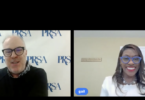Blythe Campbell, APR, will lead PRSA’s new Leadership Communication Certificate Program, which starts on Aug. 20. Among other action items, participants will learn to inspire employees, manage operations, meet organizational challenges and strengthen their teams’ communications with crucial stakeholders.
During a 30-year career in communications and marketing, Campbell has worked for eight different CEOs as a member of the executive team responsible for public relations, marketing, and employee communication. She is a speaker, trainer, coach and consultant, specializing in essential communication skills for executives and emerging leaders.
In an interview with PRsay, Campbell shares her insights on working with CEOs, leading virtual teams and overcoming barriers to management roles:
What are the main distinctions between management and leadership?
Management is an important skill that we develop early in our careers. We manage our time, projects and resources, and often begin to manage people.
Early in my career, I was promoted to office manager of a professional services firm. For the first time, I was responsible for managing people, and I made a lot of mistakes. My first mistake was assuming that I knew how to do my staff members’ jobs better than they did. They were meeting deadlines and my internal clients were pleased with their work, but they didn’t do the work the way I would have done it. It took several years for me to learn that managing outcomes, rather than processes, was the key to achieving the organization’s goals.
We can learn to be competent managers, but if we learn to lead, we can truly engage people in the work of the organization and the vision of what the organization can be at its best.
For our part as PR professionals, we observe, we listen, and we seek to understand a wide variety of audiences. Those skills are the foundation of leadership if we have the confidence to use them in our work.
You’ve worked for eight different CEOs. Is there a secret to earning the trust of senior business leaders?
A company’s senior leadership team is one of our most important audiences. We need to understand how they see the world and what they are trying to achieve. We need to understand their network and where they get their information. We need to identify and amplify their strengths and help them understand and mitigate their weaknesses.
Senior leaders must communicate effectively to achieve their goals and the organization’s goals. Since communication is our strength, as PR advisers, we are in a great position to help our company leaders communicate better.
It’s natural for us to think, for example, about how each audience might react to CEO’s decisions. Every time we help a CEO or other senior manager understand an important audience better, we build our relationship as their trusted advisers. It takes time to build that trust, but you know you have it when you are consulted on the strategy, not just on how to communicate the strategy.
During the COVID-19 crisis, how have business leaders succeeded in virtual work environments?
This global pandemic has fundamentally changed our world in the short term and will likely lead to significant long-term changes. The best business leaders recognize that these profound changes are not just about how we get our work done. They know that people are struggling to balance their personal fears, family challenges, isolation and uncertainty about the future.
In my opinion, the element that’s missing in most virtual work environments is listening. It’s hard to listen in a Zoom meeting, but there are ways to use meeting structures, chat and turn-taking to make room for listening.
Leaders also need to take time for one-on-one meetings — by videoconferencing or by phone — that used to happen organically in office settings. Some global organizations were already adept at virtual teamwork; the rest of us have a lot of room to grow.
What are the common barriers to communications leadership?
In most organizations, there’s a strong focus on short-term results. As PR leaders, we need to spend time thinking about and preparing our people for the long term. That means developing a robust internal and external network so we understand the fundamentals of our industry and the global and local trends that will impact it. I always challenge PR professionals to understand their organization’s financials as well as the CEO does, for example.
Confidence is another barrier to PR leadership. I see PR professionals who stay “in their lane” and lose the opportunity to make a difference as leaders. Confidence flows from competence. If you’re not feeling confident, then work on your competence. What skills can you build? What experiences will challenge you? Which people will inform and inspire you?
How does someone know they have become a leader?
I believe strongly that we can lead from all levels, and that we are always “becoming” leaders. If you seek to grow personally, to understand others, and to make meaningful contributions to your organizations, then you are a leader.
John Elsasser is the publications director at PRSA.
Photo credit: vlad_chorniy








